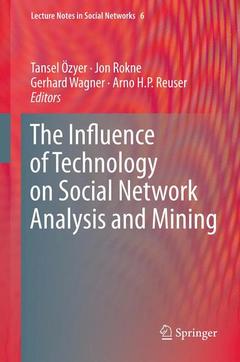Description
The Influence of Technology on Social Network Analysis and Mining, 2013
Lecture Notes in Social Networks Series
Language: English
643 p. · 15.5x23.5 cm · Paperback
Description
/li>Contents
/li>Comment
/li>
The study of social networks was originated in social and business communities. In recent years, social network research has advanced significantly; the development of sophisticated techniques for Social Network Analysis and Mining (SNAM) has been highly influenced by the online social Web sites, email logs, phone logs and instant messaging systems, which are widely analyzed using graph theory and machine learning techniques. People perceive the Web increasingly as a social medium that fosters interaction among people, sharing of experiences and knowledge, group activities, community formation and evolution. This has led to a rising prominence of SNAM in academia, politics, homeland security and business. This follows the pattern of known entities of our society that have evolved into networks in which actors are increasingly dependent on their structural embedding General areas of interest to the book include information science and mathematics, communication studies, business and organizational studies, sociology, psychology, anthropology, applied linguistics, biology and medicine.
EgoClustering: Overlapping Community Detection via Merged Friendship-Groups.- Optimization Techniques for Multiple Centrality Computations.- Application of social network metrics to a trust-aware collaborative model for generating personalized user recommendations.- TweCoM: topic and context mining from Twitter.- Pixel-Oriented Network Visualization. Static Visualization of Change in Social Networks.- Building Expert Recommenders from Email-Based Personal Social Networks.- A local structure-based method for nodes clustering. Application to a large mobile phone social network.- Virus Propagation Modeling in Facebook.- Comparing and visualizing the social spreading of products on a large social network.- Engagingness and Responsiveness Behavior Models on the Enron Email Network and its Application to Email Reply Order Prediction.- Efficient Extraction of High-Betweenness Vertices from Heterogeneous Networks.- Cross-Domain Analysis of the Blogosphere for Trend Prediction.- Informative Value of Individual and Relational Data Compared Through Business-Oriented Community Detection.- Clustering Social Networks Using Distance-Preserving Subgraph.- Extraction of Spatio-Temporal Data for Social Networks.- Detecting Communities in Massive Networks Efficiently with Flexible Resolution.- Detecting Emergent Behavior in Social Network of Agents.- Factors enabling information propagation in a Social Network Site.- Learning from the Past: An Analysis of Person Name Corrections in the DBLP Collection and Social Network Properties of Affected Entities.- Towards Leader based Recommendations.- Enhancing Child Safety in MMOs.- An Adaptive Framework for Discovery and Mining of User Profiles from Social Web-Based Interest Communities.- DB2SNA: an All-in-one Tool for Extraction and Aggregation of underlying Social Networks from Relational Databases.- Extending Social Network Analysis with Discourse Analysis - Combining Relational with Interpretive Data.- How Latent Class Models Matter to Social Network Analysis and Mining: Exploring the Emergence of Community.- Integrating Online Social Network Analysis in Personalized Web Search.- Evolution of Online Forum Communities.- Movie Rating Prediction with Matrix Factorization Algorithm.




